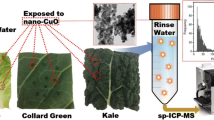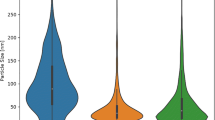Abstract
Cerium dioxide nanoparticles (CeO2NPs) are among the most broadly used engineered nanoparticles that will be increasingly released into the environment. Thus, understanding their uptake, transportation, and transformation in plants, especially food crops, is critical because it represents a potential pathway for human consumption. One of the primary challenges for the endeavor is the inadequacy of current analytical methodologies to characterize and quantify the nanomaterial in complex biological samples at environmentally relevant concentrations. Herein, a method was developed using single particle-inductively coupled plasma-mass spectrometry (SP-ICP-MS) technology to simultaneously detect the size and size distribution of particulate Ce, particle concentration, and dissolved cerium in the shoots of four plant species including cucumber, tomato, soybean, and pumpkin. An enzymatic digestion method with Macerozyme R-10 enzyme previously used for gold nanoparticle extraction from the tomato plant was adapted successfully for CeO2NP extraction from all four plant species. This study is the first to report and demonstrate the presence of dissolved cerium in plant seedling shoots exposed to CeO2NPs hydroponically. The extent of plant uptake and accumulation appears to be dependent on the plant species, requiring further systematic investigation of the mechanisms.






Similar content being viewed by others
References
Perullini M, Bilmes SAA, Jobbagy M. Cerium oxide nanoparticles: structure, applications, reactivity, and eco-toxicology. In: Nanomaterial: a danger or a promise? 2012, 307–333. doi:10.1007/978-1-4471-4213-3_12.
Deshpande S, Patil S, Kuchibhatla SVNT, Seal S. Size dependency variation in lattice parameter and valency states in nanocrystalline cerium oxide. Appl Phys Lett. 2005;87(13):133113/133111–3. doi:10.1063/1.2061873.
Schwabe F, Schulin R, Rupper P, Rotzetter A, Stark W, Nowack B. Dissolution and transformation of cerium oxide nanoparticles in plant growth media. J Nanopart Res. 2014;16(10):1–11. doi:10.1007/s11051-014-2668-8.
Collin B, Auffan M, Johnson AC, Kaur I, Keller AA, Lazareva A, et al. Environmental release, fate and ecotoxicological effects of manufactured ceria nanomaterials. Environ Sci Nano. 2014;1(6):533–48. doi:10.1039/C4EN00149D.
Cassee FR, Van BEC, Singh C, Green D, Muijser H, Weinstein J, et al. Exposure, health and ecological effects review of engineered nanoscale cerium and cerium oxide associated with its use as a fuel additive. Crit Rev Toxicol. 2011;41(3):213–29.
Zhang Z, He X, Zhang H, Ma Y, Zhang P, Ding Y, et al. Uptake and distribution of ceria nanoparticles in cucumber plants. Metallomics. 2011;3(8):816–22. doi:10.1039/c1mt00049g.
Zhao L, Sun Y, Hernandez-Viezcas JA, Hong J, Majumdar S, Niu G, et al. Monitoring the environmental effects of CeO2 and ZnO nanoparticles through the life cycle of corn (Zea mays) plants and in situ μ-XRF mapping of nutrients in kernels. Environ Sci Technol. 2015;49(5):2921–8. doi:10.1021/es5060226.
Wang Q, Ma X, Zhang W, Pei H, Chen Y. The impact of cerium oxide nanoparticles on tomato (Solanum lycopersicum L.) and its implications for food safety. Metallomics. 2012;4(10):1105–12. doi:10.1039/c2mt20149f.
Lopez-Moreno ML, de la Rosa G, Hernandez-Viezcas JA, Castillo-Michel H, Botez CE, Peralta-Videa JR, et al. Evidence of the differential biotransformation and genotoxicity of ZnO and CeO2 nanoparticles on soybean (Glycine max) plants. Environ Sci Technol. 2010;44(19):7315–20. doi:10.1021/es903891g.
Zhang P, Ma Y, Zhang Z, He X, Zhang J, Guo Z, et al. Biotransformation of ceria nanoparticles in cucumber plants. ACS Nano. 2012;6(11):9943–50. doi:10.1021/nn303543n.
Schwabe F, Tanner S, Schulin R, Rotzetter A, Stark W, von Quadt A, et al. Dissolved cerium contributes to uptake of Ce in the presence of differently sized CeO2-nanoparticles by three crop plants. Metallomics. 2015;7(3):466–77. doi:10.1039/C4MT00343H.
Degueldre C, Favarger PY. Colloid analysis by single particle inductively coupled plasma-mass spectroscopy: a feasibility study. Colloid Surf A. 2003;217(1–3):137–42. doi:10.1016/S0927-7757(02)00568-X.
Laborda F, Jimenez-Lamana J, Bolea E, Castillo JR. Selective identification, characterization and determination of dissolved silver(I) and silver nanoparticles based on single particle detection by inductively coupled plasma mass spectrometry. J Anal At Spectrom. 2011;26(7):1362–71. doi:10.1039/c0ja00098a.
Pace HE, Rogers NJ, Jarolimek C, Coleman VA, Higgins CP, Ranville JF. Determining transport efficiency for the purpose of counting and sizing nanoparticles via single particle inductively coupled plasma mass spectrometry. Anal Chem (Washington, DC, U S). 2011;83(24):9361–9. doi:10.1021/ac201952t.
Mitrano DM, Lesher EK, Bednar A, Monserud J, Higgins CP, Ranville JF. Detecting nanoparticulate silver using single-particle inductively coupled plasma-mass spectrometry. Environ Toxicol Chem. 2012;31(1):115–21. doi:10.1002/etc.719.
Pace HE, Rogers NJ, Jarolimek C, Coleman VA, Gray EP, Higgins CP, et al. Single particle inductively coupled plasma-mass spectrometry: a performance evaluation and method comparison in the determination of nanoparticle size. Environ Sci Technol. 2012;46(22):12272–80. doi:10.1021/es301787d.
Tuoriniemi J, Cornelis G, Hasselloev M. Size discrimination and detection capabilities of single-particle ICPMS for environmental analysis of silver nanoparticles. Anal Chem. 2012;84(9):3965–72. doi:10.1021/ac203005r.
Gray EP, Coleman JG, Bednar AJ, Kennedy AJ, Ranville JF, Higgins CP. Extraction and analysis of silver and gold nanoparticles from biological tissues using single particle inductively coupled plasma mass spectrometry. Environ Sci Technol. 2013;47(24):14315–23. doi:10.1021/es403558c.
Loeschner K, Brabrand MSJ, Sloth JJ, Larsen EH. Use of alkaline or enzymatic sample pretreatment prior to characterization of gold nanoparticles in animal tissue by single-particle ICPMS. Anal Bioanal Chem. 2014;406(16):3845–51. doi:10.1007/s00216-013-7431-y.
Mitrano DM, Ranville JF, Bednar A, Kazor K, Hering AS, Higgins CP. Tracking dissolution of silver nanoparticles at environmentally relevant concentrations in laboratory, natural, and processed waters using single particle ICP-MS (spICP-MS). Environ Sci Nano. 2014;1(3):248–59. doi:10.1039/c3en00108c.
Peters RJB, Rivera ZH, van Bemmel G, Marvin HJP, Weigel S, Bouwmeester H. Development and validation of single particle ICP-MS for sizing and quantitative determination of nano-silver in chicken meat. Anal Bioanal Chem. 2014;406(16):3875–85. doi:10.1007/s00216-013-7571-0.
Dan Y, Shi H, Stephan C, Liang X. Rapid analysis of titanium dioxide nanoparticles in sunscreens using single particle inductively coupled plasma-mass spectrometry. Microchem J. 2015;122:119–26. doi:10.1016/j.microc.2015.04.018.
Dan Y, Zhang W, Xue R, Ma X, Stephan C, Shi H. Characterization of gold nanoparticle uptake by tomato plants using enzymatic extraction followed by single-particle inductively coupled plasma-mass spectrometry analysis. Environ Sci Technol. 2015;49(5):3007–14. doi:10.1021/es506179e.
Donovan AR, Adams CD, Ma Y, Stephan C, Eichholz T, Shi H. Single particle ICP-MS characterization of titanium dioxide, silver, and gold nanoparticles during drinking water treatment. Chemosphere. 2016;144:148–53. doi:10.1016/j.chemosphere.2015.07.081.
Donovan AR, Adams CD, Ma Y, Stephan C, Eichholz T, Shi H. Detection of zinc oxide and cerium dioxide nanoparticles during drinking water treatment by rapid single particle ICP-MS methods. Anal Bioanal Chem Ahead Print. 2016. doi:10.1007/s00216-016-9432-0.
Loeschner K, Navratilova J, Kobler C, Molhave K, Wagner S, der KF V, et al. Detection and characterization of silver nanoparticles in chicken meat by asymmetric flow field flow fractionation with detection by conventional or single particle ICP-MS. Anal Bioanal Chem. 2013;405(25):8185–95. doi:10.1007/s00216-013-7228-z.
Degueldre C, Favarger PY, Rosse R, Wold S. Uranium colloid analysis by single particle inductively coupled plasma-mass spectrometry. Talanta. 2006;68(3):623–8. doi:10.1016/j.talanta.2005.05.006.
Degueldre C, Favarger PY, Wold S. Gold colloid analysis by inductively coupled plasma-mass spectrometry in a single particle mode. Anal Chim Acta. 2006;555(2):263–8. doi:10.1016/j.aca.2005.09.021.
Marshall AT, Haverkamp RG, Davies CE, Parsons JG, Gardea-Torresdey JL, van Agterveld D. Accumulation of gold nanoparticles in Brassic juncea. Int J Phytorem. 2007;9(3):197–206. doi:10.1080/15226510701376026.
Hineman A, Stephan C. Effect of dwell time on single particle inductively coupled plasma mass spectrometry data acquisition quality. J Anal At Spectrom. 2014;29(7):1252–7. doi:10.1039/c4ja00097h.
Pace HE, Rogers NJ, Jarolimek C, Coleman VA, Higgins CP, Ranville JF. Determining transport efficiency for the purpose of counting and sizing nanoparticles via single particle inductively coupled plasma mass spectrometry. Anal Chem. 2011;83(24):9361–9. doi:10.1021/ac201952t.
McDowell EM, Trump BF. Histologic fixatives suitable for diagnostic light and electron microscopy. Arch Pathol Lab Med. 1976;100(8):405–14.
Lee S, Bi X, Reed RB, Ranville JF, Herckes P, Westerhoff P. Nanoparticle size detection limits by single particle ICP-MS for 40 elements. Environ Sci Technol. 2014;48(17):10291–300. doi:10.1021/es502422v.
Ma Y, Zhang P, Zhang Z, He X, Li Y, Zhang J, et al. Origin of the different phytotoxicity and biotransformation of cerium and lanthanum oxide nanoparticles in cucumber. Nanotoxicology. 2015;9(2):262–70. doi:10.3109/17435390.2014.921344.
Ma Y, Zhang P, Zhang Z, He X, Zhang J, Ding Y, et al. Where does the transformation of precipitated ceria nanoparticles in hydroponic plants take place? Environ Sci Technol. 2015;49(17):10667–74. doi:10.1021/acs.est.5b02761.
Acknowledgments
The authors appreciate the financial supports from the University of Missouri Research Board and US Department of Agriculture-AFRI (no. 2011-67006-30181 and USDA-AFRI no. 2012-67005-19585). NexION 350D ICP-MS system was provided by PerkinElmer, Inc. (Shelton, CT, USA).
Author information
Authors and Affiliations
Corresponding author
Ethics declarations
Conflict of interest
The authors declare no conflict of interest.
Additional information
Published in the topical collection Single-particle-ICP-MS Advances with guest editors Antonio R. Montoro Bustos and Michael R. Winchester.
Electronic supplementary material
Below is the link to the electronic supplementary material.
ESM 1
(PDF 701 kb)
Rights and permissions
About this article
Cite this article
Dan, Y., Ma, X., Zhang, W. et al. Single particle ICP-MS method development for the determination of plant uptake and accumulation of CeO2 nanoparticles. Anal Bioanal Chem 408, 5157–5167 (2016). https://doi.org/10.1007/s00216-016-9565-1
Received:
Revised:
Accepted:
Published:
Issue Date:
DOI: https://doi.org/10.1007/s00216-016-9565-1




